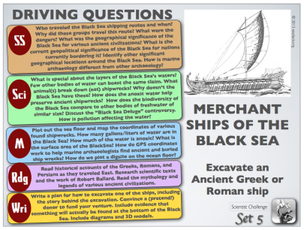
What’s more exciting than daydreaming about finding buried treasure on ancient shipwrecks?
What if we asked students to imagine themselves discovering the secrets held inside ancient Greek and Roman shipwrecks? Imagine hunting for them, deep in the murky depths of the Black Sea as the lights from our high-tech, submersible, underwater vehicles sweep left and right across the sea floor. Imagine what it would be like if we not only found them, but when we uncovered them, we actually found them completely intact, precisely as they looked when the ships went down. All the cargo still in the ship’s hold. All the sailors still aboard.
You see, that’s possible because of two amazing phenomena that happen in the Black Sea: the sea floor is a unique gelatinous substance that envelops anything of substantial weight that falls down to it; the water of the Black Sea is anoxic at a certain depth, which does not support the organisms that would normally consume the wood or other carbon-based materials that fall to the bottom of other bodies of water.
The potential to find complete shipwrecks in this environment is extremely high.
If an explorer could get into these waters, which were politically difficult to navigate for much of the 20th Century, what might we find? What would those ships have been carrying? What secrets of history are held in timeless suspension? Currently, Robert Ballard, the man who found the Titanic and the HL Hunley, is working hard to uncover and share these portals to history with today’s world.
…biology, history, geography, politics, chemistry, engineering, mathematics, archaeology, research, writing…
These are all topics ripe for exploration as students are asked to learn about the Ancient Merchant Ships of the Black Sea.
What if we asked students to imagine themselves discovering the secrets held inside ancient Greek and Roman shipwrecks? Imagine hunting for them, deep in the murky depths of the Black Sea as the lights from our high-tech, submersible, underwater vehicles sweep left and right across the sea floor. Imagine what it would be like if we not only found them, but when we uncovered them, we actually found them completely intact, precisely as they looked when the ships went down. All the cargo still in the ship’s hold. All the sailors still aboard.
You see, that’s possible because of two amazing phenomena that happen in the Black Sea: the sea floor is a unique gelatinous substance that envelops anything of substantial weight that falls down to it; the water of the Black Sea is anoxic at a certain depth, which does not support the organisms that would normally consume the wood or other carbon-based materials that fall to the bottom of other bodies of water.
The potential to find complete shipwrecks in this environment is extremely high.
If an explorer could get into these waters, which were politically difficult to navigate for much of the 20th Century, what might we find? What would those ships have been carrying? What secrets of history are held in timeless suspension? Currently, Robert Ballard, the man who found the Titanic and the HL Hunley, is working hard to uncover and share these portals to history with today’s world.
…biology, history, geography, politics, chemistry, engineering, mathematics, archaeology, research, writing…
These are all topics ripe for exploration as students are asked to learn about the Ancient Merchant Ships of the Black Sea.




 RSS Feed
RSS Feed
